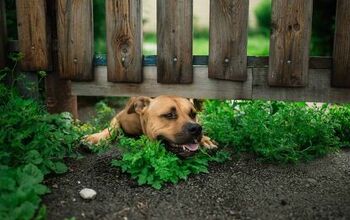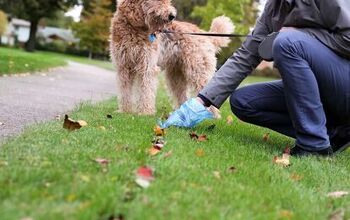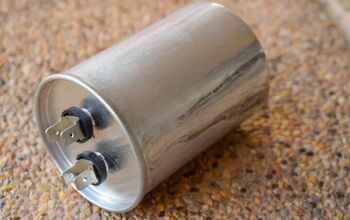How To Keep Your Dog In The Yard

We all love our dogs, and it can be stressful when they try to leave the yard. Your dog’s intentions may be good, but they don’t know how dangerous it can be to roam around. Understandably, you may struggle with how to keep your dog in the yard.
The best way to keep your dog in the yard is to build a fence that is 6-8 feet tall, so they can’t jump over it. Move climbable objects away from the fence or plant hedges and bushes to fortify your yard. You can also stop your dog from running away if you build a kennel and supervise them.
Some people must simply keep their dogs on leashes if they can’t build a fence or train them to stay in the yard. Follow along as we explore how to keep your dog in the yard to keep them safe.
Why Won’t My Dog Stay In The Yard?
Dogs often leave the yard because they are excited and distracted. They are easily stimulated by distant sights and sounds that makes them curious to discover what it's all about. It doesn’t mean they hate you or your home, but they are intrigued by something.
This often happens when you leave a dog unattended in your yard for too long. Dogs can even escape yards with fences that have gaps. Dogs also escape yards when they are bored, full of energy, and even lonely.
How To Stop Your Dog From Running Away
1. Build A Tall Fence
Sadly, not every fence can keep your dog in the yard. Low fences aren’t always tall enough to stop a dog from jumping over. Many breeds of dogs, such as German shepherds and border collies can jump over 4-5-foot fences.
Ideally, you should install a fence that is at least 6 feet tall. That is typically tall enough to stop many dog breeds from jumping over the fence. You may want to even install an 8-foot-tall fence if you have a big dog that is prone to jumping.
Vinyl fences cost $3,702 to install, on average, but you can spend up to $10,000 to install a big steel fence. The cost varies based on the materials, size of the yard, and labor. This long-term investment can keep your dog in the yard and provide privacy. It helps to plant bushes in front of the fence, so your dog won’t attempt jumping.
2. Get Rid Of Climbable Objects
Dogs seize opportunities when they see them, and that’s often how they get out of yards. For example, your dog can escape the yard even if you have a fence. That typically happens when they find climbable objects near a fence that make it easier to jump over the fence.
Keep large rocks, tree stumps, logs, and garden decorations away from your fence. This will help declutter the space and keep your dog in the yard.
3. Use Hedges
Not only do hedges increase curb appeal, but they also help keep your dog in the yard. Boxwood, holly, and privet hedges are iconic, and they make any yard look great. They are also great dense barriers that make it hard for dogs to escape your yard.
That said, you must make sure your hedges are close enough together that they’ll keep your dog in your yard. Keep in mind that it costs up to $2,200 to put hedges in a moderate-sized yard. It’s a big investment, but it provides privacy, curb appeal, and peace of mind when it comes to your dog.
Remember that hedges take a while to grow dense. Because of that, you must supervise your dog in the yard until the hedges grow thick enough to prevent your dog from getting out of the yard.
4. Supervise Them
You may not have the chance to build a fence or plant hedges if you don’t own the property. In that case, your best bet to keep your dog in the yard is to supervise them. Never leave your dog outside alone if they have a history of fleeing.
Instead, stay with them each time you take your dog outside. This is also a great chance to play with your dog and wear them out. After all, many dogs run out of yards because they simply need to release some energy. You can even keep your dog on a long leash when you let them outside to give them plenty of freedom without risk.
5. Build A Kennel
Dog kennels can keep your dog in your yard without limiting their time outdoors. That doesn’t mean you should only keep your dog in the kennel, but it helps when you can’t supervise them. You can find kennels in many shapes and sizes, but they aren’t all suited for your dog.
It’s important to consider your dog’s behavior patterns and pick a kennel based on your dog. For example, some dogs dig or jump, and that can affect how effective a kennel is. You can find kennels with barriers that prevent digging.
Try to look for tall kennels if your dog jumps high. Dog kennels cost between $230 and $3,000 depending on size, materials, layout, and labor. DIY installation is possible, but it helps to hire a professional to install the kennel.
6. Train Them
It’s no secret that dogs are quite responsive to training. You can curb many unwanted dog behaviors, and that includes leaving the yard. Walk your dog to the edge of the yard several times per day, stop, point, and say “no”.
Walk your dog back toward your house and repeat the process for several days or weeks. Eventually, walk them to the edge of the yard without a leash once you are comfortable. Clap and say “no” if they go beyond the edge of the yard.
Otherwise, you can hire a dog trainer to help keep your dog in the yard. Keep in mind that all dogs are different, so it can be hard to train them without professional help. Commands like “no”, “stay”, and “come”, don’t take too long to learn, but professional help is always welcome.
7. Keep Your Dog On A Leash
Keep your dog on a leash when you bring them outside if they consistently leave the yard. In some cases, that’s the best option if you can’t afford to build a fence or kennel right away. This may also be necessary if you have an old dog who is set in their ways.
Your dog will appreciate the time outside, and it’s worth the trouble if you want to keep your dog in the yard. This is common for renters and homeowners with small yards and shared yards. Otherwise, something as simple as your neighbor’s dog barking may be enough to make your dog leave the yard.
Are Invisible Fences Humane?
Many people believe that invisible, electric dog fences are cruel because the collars shock dogs. Sure, they can keep your dog in the yard in many cases, but they can also harm them. Some states, such as California, have outlawed electric fences unless they meet specific requirements.
Electric shock collars are also considered ineffective because dogs can still leave the yard. For example, the shock collar won’t work if your dog jumps over the invisible fence in many cases. Another downside of electric dog fences is that they can kill other animals.
That can happen if the wire becomes exposed and another animal touches or bites it. Invisible, electric fences also cost up to $3,500 to install an invisible fence.
Summing It Up
Build a tall fence or a perimeter of hedges to keep your dog in the yard. You can also train a dog to stay in the yard with command words like “stay” and “no”. Otherwise, you can build a kennel and move climbable objects away from your fence so they stay in the yard.
Related Guides:

Nick Durante is a professional writer with a primary focus on home improvement. When he is not writing about home improvement or taking on projects around the house, he likes to read and create art. He is always looking towards the newest trends in home improvement.
More by Nick Durante



























